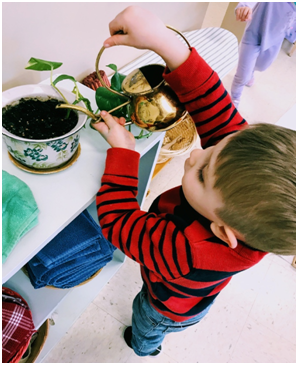Where would we be without plants? Botany is a major area of study in the Montessori curriculum, and children everywhere are fascinated by the magic of seeds, flowers, and growing plant life. Interested in finding some books to support this learning? Check out these ten titles and let us know what you think!
Against all odds, a tiny seed travels and grows to become a gorgeous flower. This delightful children’s classic covers factual topics within a storytelling format. Though many seeds may set out on their journey, few grow to complete their life cycle.
A little girl daydreams as she helps her mother in the garden. She imagines that in her garden, she wouldn’t have to worry about rabbits eating the lettuce because the rabbits would chocolate and she could eat them. The tomatoes would be as big as beach balls and the carrots would be invisible (because she doesn’t like carrots).
From Seed to Plant by Gail Gibbons
This fantastic nonfiction text helps children understand the basics of seeds and flowers. It’s bright illustrations, clear diagrams, and informative text covers topics like the parts of a flower, pollination, how seeds travel, and the stages of growth.
How a Seed Grows by Helene J. Jordan, illustrated by Loretta Kropinski
This sweet book shows two children as they plant a dozen bean seeds and observe throughout their growth. While the book gives clear directions on how to repeat the experiment, children can learn a lot just from reading. If you would like to follow along with the steps, gather some bean seeds, a bit of soil, and a dozen egg shells.
The Magic School Bus Plants Seeds by Joanna Cole, illustrated by Bruce Degen and John Speirs
Fans of the Frizz won’t be disappointed with this title! The class has grown their own garden and goes on an adventure, with the bus first turning into a ladybug to get an up-close look at a flower. They then shrink down to the size of a grain of pollen, hitching a ride on the leg of a bee and traveling down a pollen tube to learn how seeds are made.
Miss Rumphius by Barbara Cooney
A book that may inspire both you and your child, Miss Rumphius is a classic that everyone should read. Little Alice grows up, travels the world, comes home to live by the sea, and sets out to do the most difficult thing of all: do something to make the world more beautiful. Almost by accident she discovers that planting lupine seeds around her town is just the act of beauty she had been searching for.
Gregor Mendel: The Friar Who Grew Peas by Cheryl Bardoe, illustrated by Jos. A. Smith
For children in upper elementary, middle school, and perhaps even beyond, this picture book tells the story of how humble friar Gregor Mendel founded our scientific understanding of genetics. Using pea plants, Mendel discovered how traits play an important part in biology. While the importance of his work was not recognized until after his death, it played a major part in our understanding of the world.
This book begins by describing the unfortunate beginnings of Carver’s life, including being born into slavery and taken by night raiders. Following abolition, Carver lived with his former owners for a number of years, and it was during this time that he cultivated a love for plants. His curiosity and desire to further his education led him to work hard throughout his life, eventually becoming a professor at the Tuskegee Institute. It was here that Dr. Carver learned much about plants and attempted to impart his findings on the farmers of Alabama. He advocated for crop rotation as a means of long-term soil care, and studied crops such as sweet potatoes and peanuts to find ways to make them more useful and appealing to farmers and consumers.
Who Was Beatrix Potter? by Sarah Fabiny
Did you know that Potter not only wrote charming children’s books, but she was also a conservationist? During a time when women’s studies in science were not taken seriously, Potter worked to find ways to make her findings heard. She adored animals and plants, and strove to find ways to preserve nature for generations to come.
Treecology by Monica Russo, photographs by Kevin Byron
Detailed, informative, and engaging, this book delivers a combination of facts and activities that children can try to learn about trees. It received an honorable mention for the National Outdoor Book Awards and was named a 2017 Outstanding Science Trade Book for Students K-12. While all children will enjoy this book to some extent, those who are in grades 3 and above would likely get the most out of it.
As always, we would love to hear your feedback after reading some of these books. We would also love to hear about any others you think should be on the list! Happy reading!


